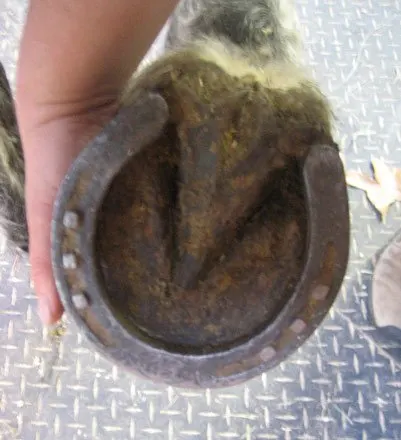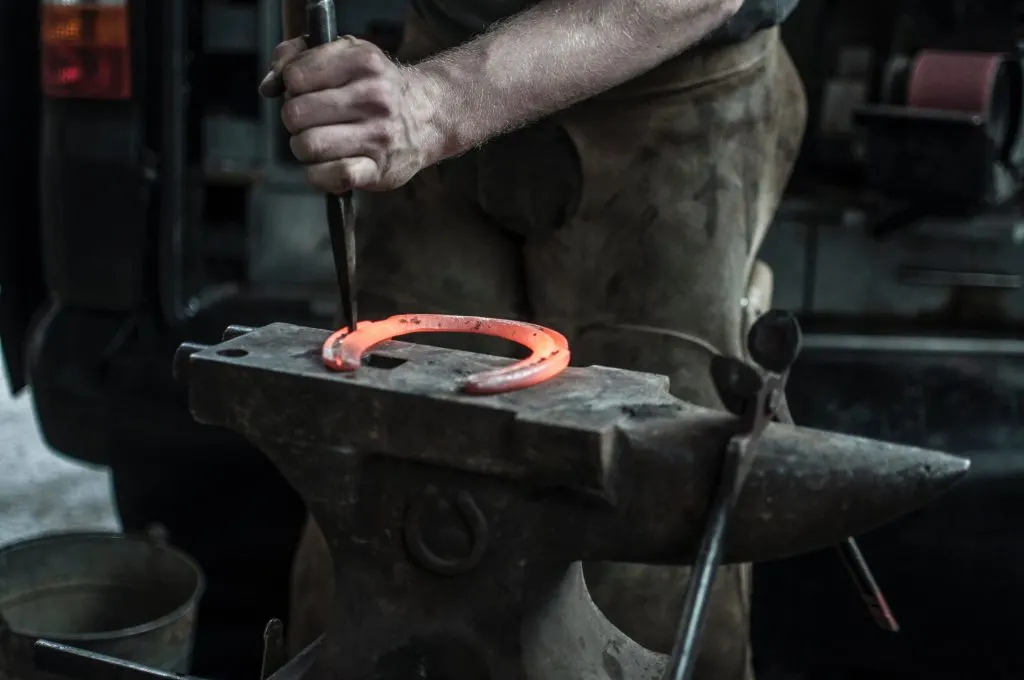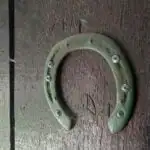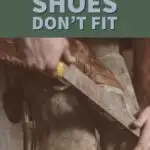Horseshoes are an important part of care for most (but not all!) horses. However, for many people new to horses, understanding horse shows and how they fit can be confusing.
In this article, I’ll share what I learned through shadowing a farrier about measuring my horse’s hoof, choosing the right type of hoof care, and how to make sure my horses’ shoes fit. With this basic guide, you’ll be well on your way to becoming a horseshoe expert in no time!
4 Signs Your Horse’s Shoes Don’t Fit
If your horse is wearing the wrong size shoe, you will probably know it. A correctly fit horseshoe is shaped to the shape of the horse’s hoof. Signs the horse shoe does fit include:
- 🔴🚩 The horse should not appear to be standing up on a platform,
- 🔴🚩 It should not appear that edges of the hoof are hanging over the edge of the metal horseshoe.
- 🔴🚩 You should not be able to see the edge of the metal horseshoe extending past the edge of the horse’s hoof (in this case, your horse is likely to pull off this poorly fit shoe by stepping on the extended portion of the shoe with another hoof).
- 🔴🚩 Another clue that your horse may be wearing the wrong size shoe is lameness. A horse that begins moving uncomfortably either immediately after or a day or two after a new pair of shoes are put on might have the wrong size horseshoes. While some soreness immediately after trimming is not a cause for alarm, outright lameness or tenderness that persists are red flags that the shoes may not be properly fit.
The back of the shoe may stick out slightly from the heel, this is an acceptable practice for farriers and can help correct movement or help prevent shoes from being pulled.
If you see any of these signs that your horse’s shoes are not fit correctly, contact your farrier, an alternate farrier, or your veterinarian.
One common question for new horse owners is knowing if their horse’s shoes fit correctly. Sometimes people ask “what size shoes” their horse might need.
These questions might raise eyebrows for experienced horse people, but they make lots of sense for those new to the world of horsemanship. After all, most things we purchase are purchased by size. When it comes to buying shoes for humans, getting the right size for a human foot is a really big deal.
Horse Term Explanation: When horse owners say a horse has “Pulled a Shoe,” they mean that the horse has, with a back hoof, stepped on the metal edge of the shoe on a front hoof. When, at the next step, the horse lifts a front hoof while the metal horseshoe is held down by the back hoof, the nails (painlessly) pull the shoe off the front hoof. This horse “pulled a shoe” and if they do it regularly, they might be called a “shoe puller” or prone to “shoe pulling.” Farriers have special shoeing methods for horses who repeatedly pull shoes.

Horseshoes are custom fit by a professional called a farrier– a farrier is a trained professional who trims and shapes horses’ hooves and (with some exceptions for horses that don’t wear shoes) then fits them with the perfect size horseshoe.
The following section may contain affiliate links. As an Amazon Associate, we earn from qualifying purchases.
How to Know if your Horse Needs Shoes
It’s important to remember that not all horses need shoes. A trend of “barefoot” horses is growing in popularity. With it, the number of farriers who are trained to be able to trim hooves in such a way that the horse is able to be in regular work without needing the support of metal horseshoes is growing.
There are also more and more options for temporary horseshoes – hoof boots – that can be put on just before riding to offer a horse extra support.
Whether your horse needs shoes or can go barefoot is highly individual to your particular horse, and something only your farrier and vet can determine
During the shoe fitting, your farrier will typically
- Evaluate your horse and how the previous set of shoes have worn – as this can provide important information on your horse’s stride and how they are wearing their shoes.
- Remove the existing shoes and trim the hooves back (horse hooves grows similarly to fingernails – hard keratinous outsides with live and highly sensitive flesh underneath.)
- Next, your farrier will choose from their supplies on hand a set of shoes that are roughly sized appropriately to your horse. The farrier will then work with both hoof and shoe to create a comfortable fit.
- In the case of “hot shoeing” the farrier will heat the horseshoe, reshape it as needed, and then press it while still hot on to the horse’s hoof creating a glove-like fit as bits of the hard outer surface of the hoof are melted back.
Learn more about what to expect during a horse farrier visit or learn what it takes to become a farrier and other horse jobs.

Horse shoes are not intended to hurt horses’ feet. In fact, they are designed to protect horses’ feet from injury. However, if they are not fitted properly, or if they are not made of the right material, they can cause horses’ feet to become sore.
Sometimes, horses are a little sore after having their hooves trimmed and new shoes put on. Barefoot horses, especially, may need a day or two to be fully comfortable with the new shape of their hooves. If you notice signs of signs of lameness that are severe OR last longer than a day, you should contact your veterinarian and farrier. Together, they can troubleshoot why your horse’s new shoes are causing them to have pain when moving.
Do horse shoes hurt horses?

Horse shoes do not hurt horses because they are designed to provide support and protection to the hoof. Horse shoes attach to a part of a hoof (similar to human hair) that does not have nerves. When fitted properly, horse shoes help horses move more confidently, which can reduce the risk of injury. When horseshoes are fitted and maintained correctly, they improve the quality of horses’ lives.
Do horses need horseshoes?
Some horses need horse shoes but other do not. Horses without horse shoes are called “barefoot” horses. Horse shoes are used most often on horses that are used for work, competition, or sport. Horseshoes can also be used to treat the symptoms of diseases that affect horse hooves.

